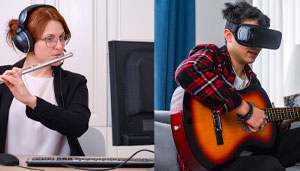Keeping a Digital YOU in the Classroom: How to Still Have a Successful Band Rehearsal with a Non-Music Substitute
By Heather DiPasquale on November 13, 2019 music directors & adjudicators article PrintPicture it. Your alarm goes off and you feel like you have been hit by a truck. That is when the bargaining starts. You think “Maybe I can make it through the day with enough Gatorade and Tylenol” or “If I can just sit down all day and teach I will be fine.” But as you hobble out of the bathroom you realize that there is no fighting it, you are going to have to write substitute plans.
Substitute plans… two words that can invoke a sense of unavoidable misery. If your district is fortunate to have substitutes with musical training you are very lucky. For the rest of us, sometimes we are just thankful that our district can find a replacement for that day. The combination of a shortage of substitutes and substitutes with non-musical backgrounds can make assembling successful substitute plans seem like an impossible task.
I wanted to move beyond videos and worksheets (that may or may not get turned in or completed) and group practice sessions that can possibly result in a sense of chaos and disorder. I wanted to generate something that would really get my students to perform at a higher level. This year as I was preparing to go to conference, I decided to make instructional play along CDs for my classes. The experiment produced great results. Not only were my students performing better, but it was like I had never been gone. The CDs were a hit and they were very successful at it!
The following information will give you an idea of how to construct your own instructional play along CDs. These function great for the times you know in advance that you are going to need a replacement. I will also examine at ways of setting up the classroom that aids the substitute during their time in the band room. Sometimes there is nothing as overwhelming as being in the band room for a substitute teacher, especially one with no musical background. I will also look at how you can adapt this to fit the unexpected absences and other ways you can modify this activity.
BEHIND THE SCENES PREPARATIONS
For the recording process I utilized Garage Band and iTunes software on my MacBook, an external microphone, a metronome, and a piano. There are other applications and operating systems out there that one can employ with the same results.
The MacBook was centrally located. My metronome and external microphone was placed to the left and the piano was situated to the right. Close proximity of the metronome and microphone improved the volume of the metronome during playback. I prefer to have the metronome louder when recording than the piano. It assisted the vertical alignment of the unison lines when they were playing. I suggest experimenting with different set ups to get the sound mix that works best for you.
The instruction was recorded using the vocal track in Garage Band. When you record you will want to wait a couple of seconds before talking to guarantee that everything you intend to record makes it on the track and that there is time for students to process all of the information. If you make an error during the recording process, there is a way to delete certain segments out of the track without having to start from scratch. However, keeping all of the tracks no longer than 3-4 minutes each will produce more of a trouble-free process. The brief duration of track also enables the students who need more practice to repeat the track or if they have already mastered a skill to progress on to the next track.
Once the recording process is complete, you can import the sound files into iTunes. To minimize any possible errors during the burning process I suggest creating a playlist and titling each track. After burning the CD, you can print off a CD jacket from the playlist in iTunes to keep the CD or multiple CDs organized and easy for the substitute to use in the classroom.
SETTING UP THE SUBSTITUTE AND STUDENTS FOR SUCCESS
A happy substitute always produces a better learning environment and experience for the students. Difficulties may arise when students do not know how to practice effectively or possess the necessary skills to self-assess. These difficulties may create an environment so chaotic and noisy for the substitute that they may not ever want to come back and substitute for you again. It is important to make sure that both parties are set up for success.
While your students know your daily routines, expectations, classroom management and procedures for the classroom, your substitute may not, especially if it is their first time in your classroom. Remembering they do not share your training will aid in articulating clear plans.
Having an easy to read copy of the classroom procedures/daily routine and expectations allows the substitute to keep the routine as normal as possible for the students. A good rule of thumb is to keep everything that you leave for them no longer that one page in large font, easy to scan with their eyes during classroom instruction, and can read in under 2 minutes.
Every class should have a seating chart clearly labeled. Creating blocks (small squares) for each student in the configuration of the class enables the substitute to have a space to record behaviors for that day. This allows the substitute a way to mark any off any disruptions without having to stop the students from performing.
There is nothing worse than coming back to your classroom and having a note that states nothing was accomplished because they could not locate the materials to use for the class. Arranging extra materials that might be needed in an easy to find spot in the order of the classes for that day minimizes any problems. Double checking that all of the technology required for the class works and is up to date (including any web links you might use) eliminates loss of instructional time for students.
Everyone loves the efficiency of a one stop shop and substitute teachers are no exception. Making a binder that has all the information needed during the course of the day creates a stress free day for everyone involved. The binder is comprised of tabbed sections (one for each class). Classroom procedures/daily routine, expectations and my cell phone number are the first two pages. Each tabbed section after that has classroom rosters, seating charts, plan for the day, and any extra copies of the materials in case they get confused on which materials go with what class.
CREATING THE LESSON (THE PROCESS)
One of the main challenges in creating the play along CD is organizing a sequence of instruction that the students can easily follow with out you being in the room. I try and keep everything very formulaic for instructional CDs. I find that the students are more successful this way when they are out of their routine. I start every track with instructions on what the goal is for the exercise followed by the start of the metronome. A metronome is used with every track and students should be comfortable and able to perform with it.
Once the metronome is started, I remind students to tap their feet along with the track, give them a count off, and play their part on piano. After the exercise is finished, instructions are given on ways to improve their next try when they repeat the exercise. The recorded track should simulate the typical classroom instruction in sound and procedure.
The first track on every CD is a welcome track for the class. The goal is to give clear and concise instructions for the day that both the students and sub can understand and follow. Outlined are helpful hints in order to stay together when playing, goals for the day, and unveiling of the student leader (quality controller). I teach at a Leader in Me school, so I am always looking to give my students leadership opportunities anywhere and everywhere I can. The play along CDs are great opportunities for student leadership. Each day that I am gone (if it happens to be multiple days in a row) I select a different student leader be the “quality control”. They get to determine if the class needs to do something over again or if they are ready to move one. I always pick a strong musician who is respected by most, if not all of their peers.
Warming up is a very important part of our daily class routine and is always the second track on the instructional CD. This track serves as a way for the students to start listening to one another by matching their sound with their neighbors, the piano, and staying with the metronome.
The next tracks on the CD will be a combination of rhythm tracks, melodic trouble spots, small segments of melody/lines, and then whole line/melody tracks. Rhythm tracks are handled in a very structured way where the students say the rhythm, clap the rhythm, sing the rhythm, and play the rhythm on one note (always with a metronome). Trouble spot tracks are designed to improve lines in the band book or longer melodies/exercises. Pick one spot that the students need to improve. Take the first two notes of that melody and have the student repeat it several times and then have them add a note and repeat the process. I have my students keep adding notes until we can play the whole measure of small chunk of music. This technique can become very tedious if done with a large musical excerpt. The whole melody/line tracks are saved for the very end of the CD. When I make these tracks I have the students air band (air, tongue and fingers silently) while I play the piano several times. Then I have the students play with the piano. These tracks are very important for the student leader. They get to determine where the mistake was made, what track to go back to, if they need to try it again, or if they can move on.
I always keep my play along CDs as close to thirty-five or forty minutes as possible. It allows for student set up and tear down of instruments without being late to the next class. It also allows for the students to be able to repeat a couple of tracks if needed and still get through the whole CD in one class period. The students have a great sense of accomplishment when they are able to finish a CD.
BEYOND PUSHING PLAY
An extension of this activity is to let the students vote on the top two best performed tracks of the class period and have them produce a recording for me to listen to and evaluate. I will train one student in every class on how to operate the video camera and assign them to be the video producers. The students really enjoy this opportunity to make their own music video of what they have accomplished that day.
Unexpected sick days leave teachers writing lesson plans when they feel the worst. What if we could create a sub tub for band of instructional CDs? Sub tubs have been paraded around Pinterest and Google for years now and for good reason. They are extremely convenient when you are not able to get into your classroom and get materials ready for your classes. They create less stress for you and your substitute.
But what would a band sub tub look like? I have mine divided up by grade level and then by concept within each grade level. Since no one ever knows when anyone is ever going to be sick I keep all of the activities unison rhythms and unison melodies. It allows for easier error detection for student leaders. I use a variety of materials like rhythm charts/grids, scale and technique exercises, and lines out of band method books. Each CD is put in a manila envelop and has the necessary number of copies of sheet music and track lists. I make sure that there are exercises that the students can be successful with at different points in development throughout the year. It is a very time consuming process but it a rewarding experience for the students while you are away.
For music educators, the experiences we provide our students are limited only by our creative capacities. Through instructional CDs my students have increased their engagement in the classroom on sub days, developed leadership qualities, and expanded their musical skills. I highly recommend trying this out in your classroom.
Heather DiPasquale
Heather DiPasquale is the band director at Todd County Middle School and assistant band direct at Todd County Central High School. She holds BM in Performance with teaching certification from Murray State University, MM in Performance, MM in Music Education, and a Graduate Certificate in Orff Schulwerk from the University of Kentucky. She can be contacted at: [email protected].
This article is a reprint first appearing in the Bluegrass Music News (Summer 2016 Issue).
Most Recent Articles







